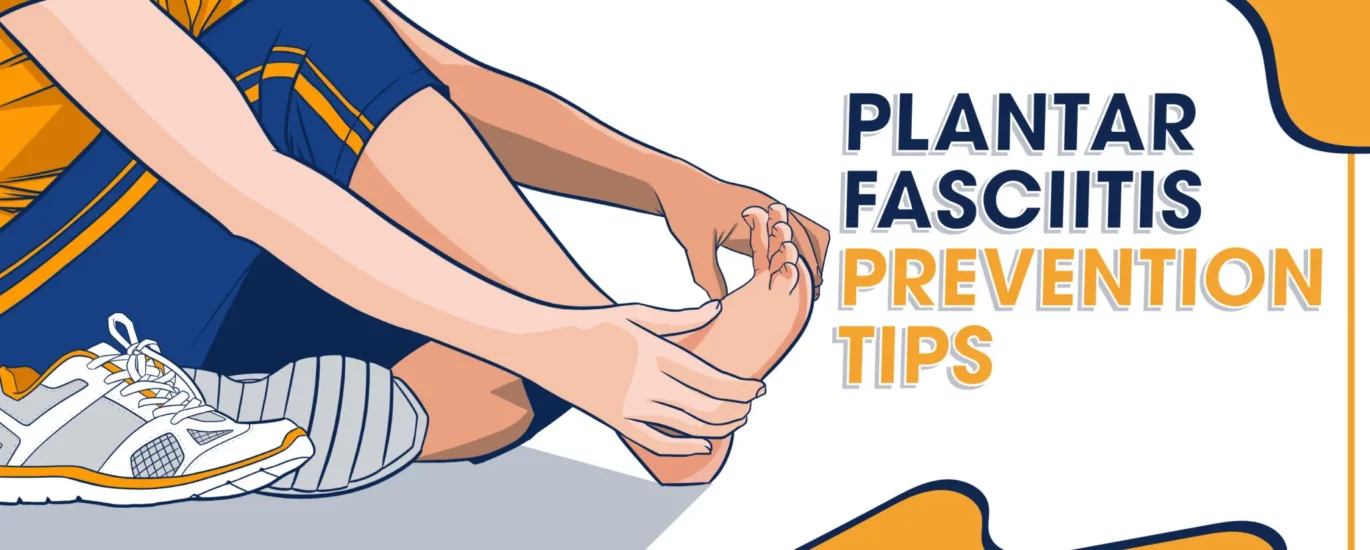


Have you ever experienced intense pain in your heel that makes it hard to walk or do daily activities? If so, you might be dealing with a condition called plantar fasciitis. It’s a common foot problem that affects many people around the world. Plantar fasciitis happens when a thick band of tissue on the bottom of your foot becomes swollen and irritated. This tissue called the plantar fascia, connects your heel bone to your toes. When it gets inflamed, it can cause a lot of discomfort and make it difficult to move around.
Dealing with plantar fasciitis can have a big impact on your foot health. The pain can be really bothersome and make it tough to do things you enjoy. Unfortunately, there are some common mistakes that people often make when trying to manage this condition, and these mistakes can actually make things worse. The purpose of this article is to help you understand what not to do when you have plantar fasciitis. By learning about these mistakes, you can avoid them and take the right steps to manage and recover from this condition.
Taking care of your feet and knowing what to avoid when you have plantar fasciitis is really important. By being aware of these common mistakes, you can make smarter choices and get the right treatments to help your feet feel better. So, let’s explore what not to do when dealing with plantar fasciitis and learn how to improve your foot health and overall well-being.
Plantar fasciitis is a foot problem that causes a lot of pain in your heel. It happens when a thick band of tissue in the bottom of your foot gets swollen and irritated. There are different reasons why someone might get plantar fasciitis. Doing activities that strain your feet too much, like running or standing for a long time, can make it more likely to happen. Having certain foot shapes, like very high arches or flat feet, can also play a role. Wearing shoes that don’t support your feet well, being overweight, and having tight calf muscles or Achilles tendons can contribute to plantar fasciitis too.
The main symptom of plantar fasciitis is a sharp, stabbing pain in your heel. It’s usually worst in the morning when you start walking or after resting for a while. It can also get worse after doing a lot of physical activity. Sometimes, the affected area may be swollen, tender, or achy. If you think you have plantar fasciitis, it’s important to see a doctor, like a foot doctor or orthopedic specialist, to get the right diagnosis. They will examine your foot, ask about your medical history, and might do some tests like X-rays or ultrasound to be sure. This is important because there are other conditions that can cause foot pain, and it’s important to know for sure what’s going on.
Getting an accurate diagnosis is important because it helps determine the right treatment plan. Every person’s plantar fasciitis is different, so the treatment should be personalized. It’s not a good idea to diagnose or treat yourself without professional help because you might end up doing things that don’t work or could even make things worse.
One of the most common mistakes people make when dealing with plantar fasciitis is ignoring the pain in their foot. It’s easy to dismiss the initial signs of discomfort as temporary or insignificant, hoping that the pain will go away on its own. However, ignoring the pain can have serious consequences for your foot health and overall well-being.
Plantar fasciitis pain typically starts as a mild ache or soreness in the heel or arch of the foot. It may be more noticeable in the morning or after periods of rest. Ignoring this early warning sign can allow the condition to progress and worsen over time. Without proper attention and treatment, the pain can become severe, making it difficult to walk or perform regular activities.
Addressing the pain promptly is important to prevent further damage and complications. By taking early action, you can prevent the condition from worsening and speed up the healing process. Ignoring the pain, on the other hand, can lead to chronic inflammation and prolonged discomfort.
Remember, timely intervention is key when it comes to plantar fasciitis. Don’t make the mistake of ignoring the pain. Addressing it promptly can help prevent further damage, reduce your pain, and increase your chances of a successful recovery.
When dealing with plantar fasciitis, one common mistake people make is overdoing physical activity without giving their feet adequate rest. Engaging in high-impact activities without proper care and rest can worsen the condition and prolong the healing process. High-impact activities put excessive strain on the plantar fascia, aggravating the inflammation and causing increased pain. Running, jogging, jumping, and other activities that involve repetitive pounding on the feet can significantly worsen plantar fasciitis symptoms. The continuous stress on the already inflamed tissue inhibits the healing process and may lead to further damage.
It is important to understand that rest is an important component of the recovery process. By overdoing physical activity and not allowing your feet enough time to rest and heal, you risk exacerbating the condition and prolonging your pain.
To avoid this mistake, it’s important to modify your activity levels and choose low-impact exercises that do not excessively strain the plantar fascia. Opt for activities such as swimming or cycling, which provide cardiovascular benefits without putting excessive pressure on the feet. Gradually increase your activity levels while ensuring you have sufficient rest periods in between.
Remember, pushing through the pain and overdoing physical activity can worsen plantar fasciitis symptoms and delay your recovery. Give your feet the rest they need, modify your activities to reduce impact, and focus on exercises that promote healing. By doing so, you can help alleviate your symptoms and facilitate a smoother recovery process.
One common mistake is wearing shoes that don’t give enough support or don’t fit well when dealing with plantar fasciitis. These shoes can make the condition worse and slow down healing. Wearing unsupportive shoes can strain the feet even more, causing more pain. Shoes that don’t fit properly can also create additional foot problems like blisters or calluses, which can make plantar fasciitis symptoms worse.

To avoid this mistake, choose shoes that give good support and cushioning. Look for sneakers with arch support and a cushioned insole. If necessary, use special inserts prescribed by a doctor. These inserts can help reduce pain and provide extra support. Remember, wearing the right shoes is important for managing plantar fasciitis. It can help reduce pain and support healing. Find comfortable shoes that fit well and give your feet the support they need.
Another mistake is not doing stretching and strengthening exercises. These exercises can help relieve pain and make your feet stronger and more flexible. Stretching exercises for the calf muscles and the plantar fascia can reduce tension and pain. Simple exercises like wall stretches or using a towel to stretch the arch of the foot can be helpful. Strengthening exercises like toe curls or ankle movements can improve foot stability.
Doing these exercises regularly is important for recovering from plantar fasciitis. Start with gentle stretches and gradually increase intensity. Be careful not to overdo it and listen to your body. Consult a doctor or physical therapist for advice on suitable exercises for your condition. They can provide personalized recommendations and make sure you’re doing the exercises correctly and safely.
Another mistake is trying to diagnose and treat yourself without seeking professional help. It is risky and can be harmful. Plantar fasciitis can be similar to other foot problems, and it’s easy to misdiagnose yourself. Using generic treatments or home remedies found online may not work for everyone. It’s important to get the right diagnosis and treatment.
To ensure accurate diagnosis and effective treatment, see a doctor, like a foot doctor. They have the knowledge and experience to evaluate your symptoms, do tests if necessary, and recommend appropriate treatments for your condition. Remember, don’t rely on self-diagnosis or self-treatment. Seek professional medical advice for the best care and to improve your chances of getting better.
To manage plantar fasciitis effectively and prevent it from coming back, there are some lifestyle changes you can make. These changes can help reduce pain, speed up healing, and lower the chances of future problems.
To manage plantar fasciitis and prevent its recurrence, consider these lifestyle changes:
By making these changes, you can manage plantar fasciitis and reduce the risk of recurrence. Consult a doctor for personalized advice.
It is important to be aware of common mistakes when dealing with plantar fasciitis to effectively manage the condition. Ignoring the pain, engaging in excessive physical activity, wearing unsupportive footwear, neglecting stretching and strengthening exercises, and self-diagnosing and self-treating can hinder the recovery process. Instead, promptly address the pain, avoid overexertion, wear supportive shoes, perform recommended exercises, and consult a doctor for accurate diagnosis and proper treatment. Additionally, making lifestyle modifications such as maintaining a healthy weight, taking breaks from prolonged standing, and using supportive footwear regularly can contribute to managing plantar fasciitis. By avoiding these mistakes and adopting a comprehensive approach, individuals can alleviate pain, promote healing, and improve their foot health.
Read Also: 5 Best Exercises For Knee Problems To Reduce Pain